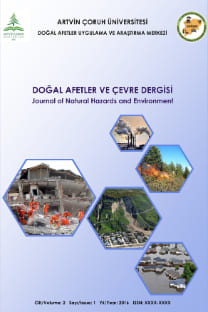Uzun ve Kısa Süreli Periyotlarda Kuraklık Analizi: Bursa Örneği
Drought Analysis in Long and Short Term Periods: Bursa Case
___
- Bacanlı U.G., (2017), Application of Linear Stochastic Models for Drought Forecasting, 3rd International Conference On Engineering and Natural Sciences, ICENS 2017, May 3-7, Budapest, Hungary, ss.590-596.
- Bacanlı U.G., Baran T., Dikbas F., (2017), Paylaştırılmış entropi kavramının kuraklık ölçütü olarak kullanılabilirliği, Pamukkale Üniversitesi Mühendislik Bilimleri Dergisi, 23(3), 232-237.
- Bacanlı U.G., Dikbaş F., Baran T., (2011), Meteorological Drought Analysis Case Study, Central Anatolia. Desalination and Water Treatment, 26, 1-10.
- Baran T., Bacanlı U.G., Dikbas F., (2017), Drought analysis with SPI ındex and entropy, European Water., 60, 263-270.
- Bayazıt M., Yeğen Oğuz E.B., (2005), Mühendisler için İstatistik, Birsen Yayınevi, İstanbul, 198ss.
- Cancelliere A., DiMauro G., Bonaccorso B., Rossi G., (2007), Drought forecasting using the Standardized Precipitation Index, Water Resources Management, 21(5), 801-819.
- Chen S.T., Kuo C.C., Yu P.S., (2009), Historical trends and variability of meteorological droughts in Taiwan/Tendances historiques et variabilité des sécheresses météorologiques à Taiwan, Hydrological Sciences Journal, 54, 430-441.
- Fontaine M.M., Steinemann A.C., (2009), Assessing vulnerability to natural hazards, impact-based method and application to drought in Washington state, Natural Hazards Review, 10(1), 11–18.
- Gocic M., Trajkovic S., (2014), Spatiotemporal characteristics of drought in Serbia, Journal of Hydrology, 510, 110–123.
- Guhathakurta P., Menon P., Inkane PM., Krishnan U., Sable S.T., (2017), Trends and variability of meteorological drought over the districts of India using standardized precipitation index, Journal of Earth System Science, 126:120.
- Guttman N.B., (1998), Comparing the Palmer Drought Index and the Standardized Precipitation Index, Journal of American Water Resources Association, 34(1), 113-121.
- Guttman N.B., (1999), Accepting the Standardized Precipitation Index: A calculation algorithm, Journal of American Water Resources Association, 35(2), 311-322.
- Kallis G., (2008), Droughts, Annual Review of Environment and Resources, 33, 85-118.
- Keyantash J., Dracup J., (2002), The quantification of drought: An evaluation of drought indices, Bulletin of the American Meteorological Society, 83(8), 1167-1180.
- Labedzki L., (2017), Categorical Forecast of Precipitation Anomaly Using the Standardized Precipitation Index SPI, Water, 9(8), 1- 14.
- Liu L., Hong Y., Bednarczyk N.C., Yong B., Shafer A.M., Riley R., Hocker E.J., (2012), Hydro-Climatological Drought Analyses and Projections Using Meteorological and Hydrological Drought Indices: A Case Study in Blue River Basin, Oklahoma, Water Resources Management, 26(1), 2761-2779.
- Liu L., Yang H., Hocker J.E., Shafer M.A., Carter L.M., Gourley J.J., Bednarczyk N.C., Yong B., Adhikari P., (2012), Analyzing projected changes and trends of temperature and precipitation in the southern USA from 16 downscaled global climate models, Theoretical and Applied Climatology, 109, 345–360.
- Mallya G., Mishra V., Niyogi D., Tripathi S., Govindraju R.S., (2016), Trends and variability of droughts over the Indian monsoon region, Weather and Climate Extremes, 12, 43-68.
- McKee T.B., Doesken N.J., Kleist J., (1993), The relationship of drought frequency and duration to time steps, Preprints, 8th Conference on Applied Climatology, January 17–22 Anaheim, California, ss.179–184.
- Mckee T.B., Doesken N.J., Kleist J., (1999), Drought monitoring of climate, Geographical Reviews, 38, 55-94.
- MGM, (2018), Meteoroloji Genel Müdürlüğü, https://www.mgm.gov.tr/veridegerlendirme/il-ve-ilceler-istatistik.aspx?m=BURSA, [Erişim 08 Mart 2018].
- Mishra A., Singh V., (2011), A review of drought concepts, Journal of Hydrology, 391(1–2), 202–216.
- Raziei T., Saghafian B., Paulo A.A., Pereira L.S., Bordi I., (2009), Spatial patterns and temporal variability of drought in western Iran, Water Resources Management, 23(3), 439-455.
- Sırdaş S., Şen Z., (2003), Spatio-temporal drought analysis in the Trakya region, Turkey, Hydrological Sciences-Journal-des Sciences Hydrologiques, 48(5), 809-821.
- Thom H.C.S., (1958), A note on the Gamma Distribution, Monthly Weather Review, 86(4), 117-122.
- Topçu E., Seçkin N., (2013), L-Momentler ve Standart Yağış İndeksi (SPİ) yardımıyla Seyhan Havzası kuraklık analizi, Ç.Ü Fen ve Mühendislik Bilimleri Dergisi, 29(1), 19-28.
- Vicente-Serrano S.M., González-Hidalgo J.C., DeLuis M., Raventós J., (2004), Drought patterns in the Mediterranean area: the Valencia region (eastern Spain), Climate Research, 26(1), 5-15.
- Wu H., Hayes M.J., Weiss A., Hu Q., (2001), An evaluation of the standardized precipitation index, the China-Z index and the statistical Z-score, International Journal of Climatology, 21(6), 745-758.
- Wu H., Hayes M.J., Wilhite D.A., Svoboda M.D., (2005), The effect of the length of record on the standardized precipitation index calculation, International Journal of Climatology, 25(4), 505-520.
- Yuan Y., Zhou W., (2008), Influences of the Indian Ocean Dipole on the Asian summer monsoon in the following year, International Journal of Climatology, 28(14), 1849–1859.
- Zarch M.A.A., Sivakumar B., Sharma A., (2015), Droughts in a warming climate: A global assessment of Standardized precipitation index (SPI) and Reconnaissance drought index (RDI), Journal of Hydrology, 526, 183–195.
- Zhang Q., Xiao M., Singh V.P., Li J., (2012), Regionalization and spatial changing properties of droughts across the Pearl River basin, China, Journal of Hydrology, vol. 472-473, 355-366.
- ISSN: 2528-9640
- Yayın Aralığı: Yılda 2 Sayı
- Başlangıç: 2015
- Yayıncı: Artvin Çoruh Üniversitesi Doğal Afetler Uygulama ve Araştırma Merkezi
Türkiye’de Seçilen Hava Kalitesi İzleme İstasyonları için Eğilim (Trend) Değerlendirmeleri
Büyük Menderes Grabeninde Cisim Dalgalarının Frekans Bağımlı Soğrulma Karakterinin Belirlenmesi
Atık Andezit Tozu ve Uçucu Küllerin Betonda Kullanımının Karşılaştırılması
Bütünleşik Afet Yönetiminde Sendai Çerçeve Eylem Planının Beklenen Etkisi
Kahramanmaraş Domuz (Boğaz) Deresi Kuşaklama Kanalının HEC-RAS Modeli
Burcu ERCAN, Ayşe ECE YAĞCI, MEHMET ÜNSAL
Bir Hastanede İç Hava Kalitesinin Araştırılması: Şanlıurfa’dan Örnek Bir Çalışma
2017 Ayvacık Depremlerinden Etkilenen Yukarıköy Geleneksel Taş Evlerinin Durumu
Ali Rıza PARSA, Ali Osman KURUŞCU
Bitlis Hava Kirliliği Emisyon Envanteri ve Sağlık Etkilerinin Çoklu Lineer Regresyonla Tahmini
